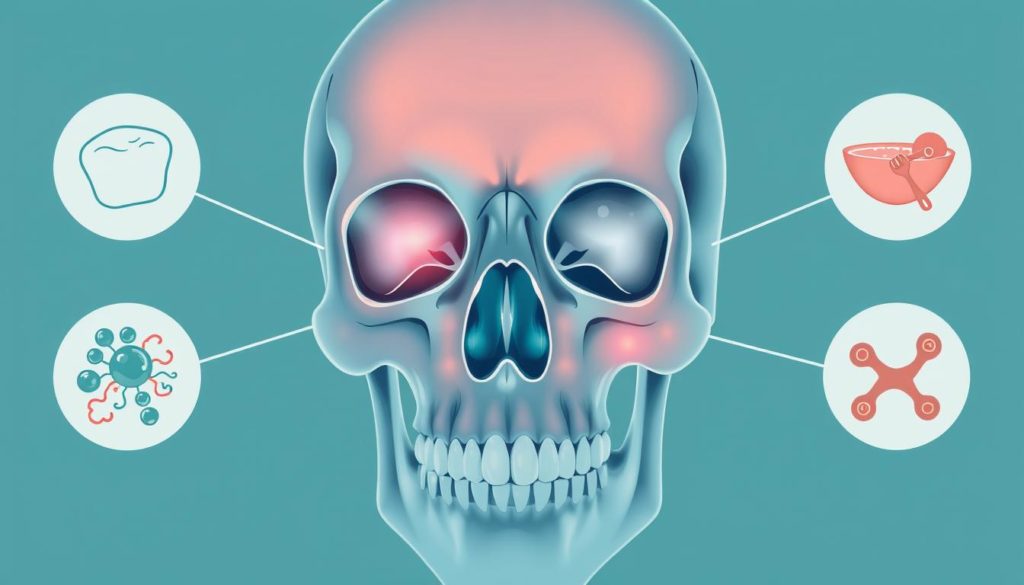Did you know nearly 40% of American adults get a toothache every year? This shows how common dental pain is. When you have a toothache, knowing how to get quick relief is key to feeling better.
It’s important to understand what causes toothaches to find the best treatments. This guide will help you manage dental pain. You’ll learn how to get relief at home and when to see a dentist, with advice from the American Dental Association.
Keep reading to find out how to ease your toothache pain at home. These methods are easy to try and can help you feel better fast.
Understanding the Causes of Dental Pain
Dental pain can be really upsetting, especially when you don’t know why it’s happening. Many things can cause toothaches, from common dental problems to how we live our lives.
Common Reasons for Toothaches
Toothaches often come from tooth decay, which is when cavities get too deep. Gum diseases like gingivitis and periodontitis also play a big role. The Mayo Clinic says infections in the dental pulp or severe enamel erosion can cause sharp pain that needs quick help.
How Lifestyle Choices Impact Dental Health
Our lifestyle choices really affect our teeth and gums. Harvard Health Publications notes that eating too much sugar and acidic foods can wear down enamel, causing sensitivity and pain. Smoking also harms gums and slows down healing. Keeping up with good oral care is key to avoiding these problems and keeping your teeth healthy.

When to Seek Professional Help
Knowing when to see a dentist is important. The American Dental Association says to go if the pain lasts more than two days, gets worse, or comes with swelling, fever, or ear pain. Getting help early can stop small problems from getting worse and keep your teeth in top shape.
Top Home Remedies for Soothing Toothaches
Looking for ways to ease toothache pain at home can be very helpful. We’ll look at some natural ways to make your dental pain better. These methods can help you feel better fast and naturally.
Applying a Cold Compress
A cold compress can quickly ease toothache pain and swelling. Place a cold pack on the sore area for 15-20 minutes. This can numb the pain and reduce swelling. It’s a simple yet effective way to treat toothaches.
Saltwater Rinse for Relief
Using warm saltwater to rinse your mouth is another great way to ease toothache pain. Salt has antibacterial properties that can help fight mouth bacteria. This can reduce swelling and inflammation. Mix half a teaspoon of salt in warm water, swish it around, and spit it out.
Using Clove Oil for Pain Relief

Clove oil is known for its pain-relieving properties. It contains eugenol, a natural painkiller found in cloves. To use it, soak a cotton ball in the oil and apply it to the sore area. Or, mix a few drops of clove oil with water for a mouth rinse.
Over-the-Counter Solutions for Toothache Relief
Finding quick relief from tooth pain can be really tough. Luckily, there are many over-the-counter toothache remedies. They can help you manage the pain until you can see a dentist.
Pain Relievers and Anti-Inflammatories
Pain relievers like ibuprofen and acetaminophen are great for toothache relief. They not only reduce pain but also lessen inflammation. The FDA says these meds work well for short-term pain relief.
Dental Gels and Topical Remedies
Topical dental treatments, like over-the-counter dental gels, offer fast relief. These gels, often with benzocaine, numb the pain area. WebMD says they’re great for severe pain.
When to Consider OTC Solutions
Knowing when to use over-the-counter remedies is key. The American Dental Association says to use them as temporary fixes. If your toothache lasts more than a few days or is very bad, see a dentist right away.
Immediate Relief Tips for Severe Toothache
A severe toothache can be very painful, needing immediate toothache care. It’s important to find quick ways to ease the pain. Here are some tips for emergency dental pain relief:
- Rinse with Warm Saltwater: Mix a teaspoon of salt in warm water. Swish it around your mouth to clean and soothe.
- Use a Cold Compress: Put an ice pack on your cheek over the pain for 15-20 minutes. It helps reduce swelling and numbs the pain.
- Over-the-counter Pain Relievers: Ibuprofen or acetaminophen can help with immediate toothache care. They reduce pain and swelling. Always take the right amount.
- Apply Clove Oil: Put a small amount of clove oil on a cotton ball and place it on the tooth. It has natural pain relief and antibacterial properties.
If you have a severe toothache, you need to decide if you need emergency dental pain relief. If the pain doesn’t go away or is very bad, see a dentist. These steps can help until you can get to a dentist.
| Method | Action | Notes |
|---|---|---|
| Saltwater Rinse | Soothes and cleans | Use warm water |
| Cold Compress | Reduces swelling | 15-20 minutes application |
| OTC Pain Relievers | Reduces pain | Follow dosage instructions |
| Clove Oil | Natural anesthetic | Apply with cotton ball |
Avoiding Common Irritants to Reduce Sharp Tooth Pain
To reduce sharp tooth pain, it’s key to know and avoid common irritants. This includes what you eat and how you take care of your teeth. These steps can really help ease the pain.
Foods and Drinks to Avoid
Some foods and drinks can hurt your teeth. Try to cut down on acidic drinks like soda and citrus juices. Also, avoid caffeinated drinks and sweet, sticky candies. They can cause cavities and tooth decay.
Maintaining Good Oral Hygiene
Good oral hygiene is key to avoiding tooth pain. Brush your teeth twice a day with fluoride toothpaste. Flossing regularly helps remove plaque and food bits. Using mouthwash can also protect against bacteria.
Importance of Regular Dental Check-Ups
Regular dental visits are crucial for your teeth. The CDC says you should go to the dentist every six months. These visits help catch problems early and prevent toothaches.
| Irritants | Reason |
|---|---|
| Acidic Drinks | Cause enamel erosion |
| Sugary Foods | Contribute to cavities and decay |
| Poor Oral Hygiene | Leads to plaque build-up and gum disease |
Professional Treatments for Persistent Toothaches
If home care doesn’t work, you need to see a dentist. We’ll look at some important dental treatments.
Dental Fillings and Repairs
Dental fillings are key for toothaches. They fix cavities and small damage. The American Dental Association says they stop decay and pain.
Root Canals and Other Procedures
Root canal treatments help with deep infections. The American Association of Endodontists says they remove bad tissue. This brings long-lasting pain relief and health back to your tooth.
Understanding the Recovery Process
After treatments like dental fillings or root canal, knowing how to recover is important. The National Health Service (NHS) gives advice on care. Following these tips helps avoid more pain and problems.
Preventive Measures to Avoid Toothache
Preventing toothaches starts with proactive steps. By following key preventive measures, you can keep your teeth and gums healthy. Here are some important practices:
Proper Brushing and Flossing Techniques
Brushing and flossing right is the foundation of toothache prevention. The American Dental Association says using the correct techniques helps keep plaque away. This keeps your teeth and gums in top shape.
- Brush at least twice a day with fluoride toothpaste.
- Use a toothbrush with soft bristles to avoid damaging gums.
- Floss daily to remove food particles and plaque between teeth.
Dietary Changes for Better Oral Health
Changing your diet is also crucial. The American Dietetic Association says a balanced diet is key. It should include foods that strengthen tooth enamel and support dental health.
| Food | Benefits |
|---|---|
| Dairy Products | Rich in calcium and phosphates for stronger teeth |
| Crunchy Vegetables | Increase saliva production, which naturally cleanses teeth |
| Water | Keeps saliva levels high, essential for washing away food particles |
Recognizing Early Warning Signs
Being aware of early signs is vital. The National Institute of Dental and Craniofacial Research advises watching for sensitivity, bad breath, or tooth color changes. These can signal dental problems.
- Sensitivity to hot or cold fluids
- Persistent bad breath
- Changes in tooth color or appearance
Understanding Tooth Sensitivity and Its Management
Tooth sensitivity is a common problem for many. This section will explore the causes, treatments, and ways to prevent it.
Causes of Tooth Sensitivity
Tooth sensitivity comes from different sources. The American Academy of Periodontology says enamel erosion is a main cause. Gum recession and too much plaque also play a part.
Effective Treatments for Sensitive Teeth
There are many ways to treat sensitive teeth. Dental experts recommend using desensitizing toothpaste and mouthwashes. Colgate-Palmolive also suggests fluoride treatments to strengthen enamel and lessen sensitivity.
Preventing Further Sensitivity
Preventing sensitivity is key. Sensodyne’s research shows using soft-bristled toothbrushes and gentle brushing is crucial. Also, avoiding acidic foods and drinks helps keep enamel strong.
| Cause | Treatment | Prevention |
|---|---|---|
| Enamel Erosion | Fluoride Treatments | Avoiding Acidic Foods |
| Gum Recession | Desensitizing Toothpaste | Gentle Brushing |
| Plaque Buildup | Mouthwashes | Regular Dental Check-Ups |
Why Toothaches Occur: An In-depth Look
Toothaches are complex and can be caused by many factors. Understanding these causes is key. Dental infections and gum disease are among the main culprits.
Detailed Examination of Toothache Causes
Toothaches can stem from various issues. These range from small problems like cavities to serious conditions like abscesses. The Journal of Dental Research lists several common causes:
- Cavities
- Cracked Teeth
- Exposed Tooth Root
Impact of Dental Infections on Pain
Dental infections, like abscesses, can make pain worse. These infections attack the pulp and nerves of the tooth. This leads to sharp, throbbing pain and requires quick medical attention.
Role of Gum Disease in Toothaches
Gum disease also plays a big role in toothaches. The CDC says gum disease, like gingivitis and periodontitis, weakens tooth support. This can cause toothaches, swelling, and even tooth loss. Early treatment is crucial to avoid these problems, the American Academy of Periodontology stresses.
| Condition | Symptoms | Impact on Toothache |
|---|---|---|
| Cavities | Pain, Sensitivity | Localized Toothache |
| Dental Infections | Swelling, Fever | Severe, Radiating Pain |
| Gum Disease | Bleeding Gums, Bad Breath | Diffuse, Tender Toothache |
Quick Emergency Toothache Tips for Relief
When you get an emergency toothache, finding quick relief is crucial. Good urgent dental pain management can really help. Here are some fast tips to ease your pain:
- Rinse with warm saltwater: This can help reduce infection and provide some quick toothache relief.
- Apply a cold compress: Place a cold pack on the affected area for 15 minutes to alleviate an emergency toothache.
- Use over-the-counter pain medication: Ibuprofen or acetaminophen can offer urgent dental pain management, reducing swelling and discomfort.
- Try clove oil: Dab a small amount on a cotton ball and apply it to the painful area for relief.
- Hydrogen peroxide rinse: Dilute with water and swish to kill bacteria and reduce pain.
These strategies are safe, fast, and effective in addressing emergency toothache situations.
For quick toothache relief and effective urgent dental pain management, knowing these tips can truly save the day. However, always follow up with a dental visit to address the underlying cause of the pain and prevent future issues.
| Remedy | Benefits |
|---|---|
| Warm Saltwater Rinse | Reduces Infection |
| Cold Compress | Decreases Swelling |
| Over-the-Counter Medication | Relieves Pain Quickly |
| Clove Oil | Natural Analgesic |
| Hydrogen Peroxide Rinse | Kills Bacteria |
Remember, while these emergency solutions provide immediate relief, they are not substitutes for professional dental treatment.
When to Seek Emergency Toothache Treatment
Knowing when to get help for a toothache is key to keeping your teeth and health safe. Pain that won’t go away or severe symptoms mean you need help fast. The American Dental Association says certain signs mean you should see a dentist right away.
- Unrelenting pain that doesn’t subside with over-the-counter pain relievers
- Swelling of the gums or face, potentially indicating infection
- Bleeding that doesn’t stop, which can point to severe gum issues
- A knocked-out tooth, where immediate action can save the tooth
- Visible abscess or severe infection around the tooth
The Academy of General Dentistry says to see a dentist if home treatments don’t work. Dental emergencies need special care that only a dentist can give.
If you need urgent help, the Red Cross has steps to follow:
- Contact your dentist as soon as possible to explain your symptoms and get recommendations.
- Use a cold compress to manage pain and reduce swelling temporarily.
- Avoid irritating the affected area with hot, cold, or sugary foods and drinks.
- Stay calm and follow professional advice until you receive proper dental care.
Getting help quickly can stop bigger problems and help manage your toothache. Knowing when to ask for help is crucial for good treatment.
Best Practices for Long-term Toothache Prevention
Keeping your teeth healthy for the long run is more than just brushing and flossing. The American Dental Hygienists’ Association suggests a detailed oral care plan. This includes using fluoride toothpaste, changing your toothbrush every three to four months, and brushing your tongue to get rid of bacteria.
What you eat matters a lot for your teeth. The USDA says eating a balanced diet with less sugar and acidic foods helps keep teeth strong. Foods rich in calcium, like dairy and leafy greens, are especially good for your teeth.
Don’t forget about regular dental visits. The National Institute of Dental and Craniofacial Research says these visits can catch problems early. Try to go to the dentist at least twice a year. This helps catch toothaches early and keeps your mouth clean.
FAQ
What are some quick toothache relief tips? (Section 1)
For quick relief, try rinsing with warm saltwater or using a cold compress. Over-the-counter pain relievers like ibuprofen can also help. But, if the pain doesn’t go away, you might need to see a dentist.
What are the common causes of toothaches? (Section 2)
Toothaches can come from tooth decay, gum disease, or dental infections. They can also happen due to tooth fractures. Poor oral hygiene and smoking can make dental problems worse.
How can I soothe my toothache at home? (Section 3)
To soothe a toothache at home, try a cold compress or saltwater rinse. Clove oil can also provide temporary relief. These methods can help until you can see a dentist.
What over-the-counter solutions are best for toothache relief? (Section 4)
For toothache relief, use pain relievers like ibuprofen or acetaminophen. Dental gels and creams can also help. Always follow the instructions on the packaging or your dentist’s advice.
What should I do if I have a severe toothache? (Section 5)
For severe toothaches, use a cold compress and over-the-counter pain relievers. If the pain gets worse, go to the emergency dentist. They can help with infections.
What foods and drinks should I avoid to reduce sharp tooth pain? (Section 6)
Avoid hot, cold, or sugary foods and drinks to reduce tooth pain. Good oral hygiene and regular dental visits are also key. They help prevent sharp pains.
What professional treatments are available for toothaches that won’t go away? (Section 7)
For toothaches that won’t go away, you might need dental fillings or root canals. Your dentist can find the cause and suggest the right treatment.
How can I prevent toothaches? (Section 8)
Prevent toothaches by brushing and flossing well. Make healthy food choices and watch for early signs of dental problems. Regular dental check-ups are crucial.
What causes tooth sensitivity and how can it be managed? (Section 9)
Tooth sensitivity can come from enamel loss, gum recession, or cavities. Use desensitizing toothpaste and fluoride treatments. Avoid acidic foods and brush properly to prevent sensitivity.
Why do toothaches occur? (Section 10)
Toothaches can be caused by infections, cavities, or gum disease. Knowing the causes and getting prompt dental care can help manage and prevent pain.
What are quick emergency toothache tips? (Section 11)
For emergency toothaches, rinse with warm saltwater and use a cold compress. Over-the-counter pain medication can also help. If the pain is severe, see an emergency dentist.
When should I seek emergency toothache treatment? (Section 12)
Seek emergency treatment for severe pain, swelling, or fever. These signs could mean a serious dental issue that needs professional help.
What are the best practices for long-term toothache prevention? (Section 13)
For long-term prevention, keep up with oral hygiene and eat well. Regular dental visits and proper brushing and flossing are key to dental health.


